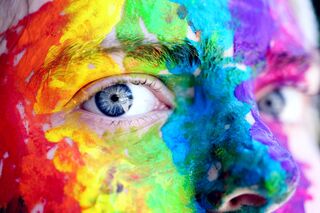
Source: Sharon McCutcheon/Pexels
Our society loves to place people in socially constructed categories. We are often reduced to our racial, gender, ethnic, or weight-based indicators, ignoring the richness of who we are beyond the membership cards slapped on us as individuals assigned to these groups.
Membership in such groups often carries substantial consequences. It will come as a surprise to no one to learn that those memberships can affect one’s job prospects, the pool of potential romantic partners, reputation, and, in extreme cases in our not too distant history, can even constitute a death sentence. The majority of my own family was exterminated some 80 years ago. Their only deadly sin? Being Jewish. Socially constructed categories matter.
One’s sexual orientation serves as a basis for a social category assignment that also carries substantial implications (including the dire death sentence even today ).
In most Western societies, the last couple of decades show a pronounced improvement in how sexual minorities are being portrayed and treated. Individuals who identify as LGBTQIA+ are freer than ever to tie their lives to a same-sex partner in legally sanctioned marriages, adopt children with their same-sex partner, or engage a surrogate to help them conceive their own child. I’m glad I live in a time of such improvements to our social fabric.
Research indicates that this greater acceptability coincides with an increase in public perception that one’s sexual orientation is determined by one’s genes. Not only that those two things coincide, research also demonstrates that to a large extent, people’s perception that homosexuality is genetically determined, actually leads to more acceptance.
However, there is no ‘Gay Gene’ as many people seem to believe. Moreover, there is research that suggests homosexuality (or sexual orientation more broadly) is not determined by genes.
This is not to say that our genes do not play a large, important role in determining the gender of the individuals we find ourselves attracted to, they do. That said, they do not determine it. Much research indicates that other elements are involved. For example, monozygotic (identical) twins sometimes have different sexual orientations despite having (almost) identical genomes.
So, it seems like many people may (explicitly or implicitly) condition their acceptance of sexual minorities on a well-advertised etiological claim that our science cannot support.
Much of my research to date has focused on the development, maintenance, and ultimately, consequences of perceiving different human phenomena (and socially constructed groupings) to emerge from our genes. Termed genetic essentialism, people seem to show an array of cognitive biases when they believe that our genes are involved in causing specific tendencies. When encountering such an etiological claim, they tend to see the tendency as more deterministic, less malleable, and more natural (and, by extension, more acceptable or good). When it comes to social categorization, they see the groups of individuals who share the perceived causal gene(s) as more homogenous (intragroups) and more distinct from other groups.
As a researcher who examines questions related to genetic essentialism on the one hand, and questions that revolve around sexual orientation on the other hand, the intersection of these areas was particularly intriguing for me.
Specifically, as one of the cognitive biases that seem to emerge from exposure to genetic etiological claims that relate specific traits to social groups (e.g., the infamous Bell Curve that suggests racial differences in intelligence based on genetics) revolves around discreteness—that is, the boundaries between the different groups are being strengthened—I wanted to see if by attacking the discreteness component directly, we can get people to reconsider even their own category membership.
I was not alone on that quest. Dr. James Morandini, a brilliant researcher who shares my intersecting foci on essentialism and on sexual orientation, was not only instrumental to this project, he actually led it. We were both joined by James’s honor student, Liam Dacosta, who worked tirelessly alongside us in exploring the question we set out to examine: Would straight people re-evaluate their own sexual orientation when we chip at the perception that sexual orientation itself divides individuals into categories with clear boundaries between them?
I’ll give you the spoiler first: they do.
Our Scientific Reports paper contains two studies, one on a convenient sample of psychology students from the University of Sydney. The other collected data on an Australian-wide community sample. I’ll restrict my following points to the second, larger study, but I urge the interested reader to check out the actual publication to see how the younger, more progressive group of university students did as well.
All participants self-identified as ‘straight’ before the study began. Each participant was assigned to one of five conditions, which only differed in the type of reading they were given. Each condition was assigned a one-page informational article. One article suggested that scientific research has found that there are many gradations of sexual attraction towards men and women, and people can fall anywhere along the continuum, from exclusive attraction to men to exclusive attraction to women. Another informational article argued that sexual orientation can change over time, and thus can be fluid. The third and fourth articles touted the conventional perceptions that sexual orientation is captured by distinct categories (homosexuality, bisexuality, and heterosexuality) or that it is stable throughout one’s life. A fifth article about trees, served as our control so we can compare the difference that would emerge from the responses in the experimental conditions to it.
Compared to the control group, after reading the continuous article, participants were 28 percent more likely to identify as non-exclusively heterosexual, and 19 percent indicated they would be more willing to engage in same-sex sexual activities. Overall, the rate of ‘non-exclusive heterosexuality’ more than quadrupled after this reading. Similar, albeit weaker, effects were found when people read that sexual orientation is better characterized as fluid rather than stable throughout life.
Our findings do not demonstrate some magical conversion abilities on our part. As Morandini likes to say, “Did we change people’s sexual orientation via our interventions? Surely not. I think our study may have changed how people interpreted their underlying sexual feelings. This means two people with identical sexual orientations could describe their sexual orientation quite differently, depending on whether they have been exposed to fluid or continuous ways of understanding sexuality.”
To James’s thoughtful insight, I’d add that ‘non-exclusive heterosexuals’ (as opposed to bisexual, gay, or lesbian individuals), although being the biggest same-sex attracted group, are not well captured in our society’s representations and even vernacular. By presenting them with (scientifically-based) arguments that sexual orientation is not taxonomic but rather reflected on a spectrum (or perhaps changes as years go by), we generated some introspection that resulted in greater self-openness about their own sexuality. Instead of resorting to erecting tall boundaries between perceived sexual-orientation categories to increase acceptance of sexual minority groups, as is the case with genetic etiological claims, we lowered the boundaries so that the categorization itself would lose some of its potency
.








